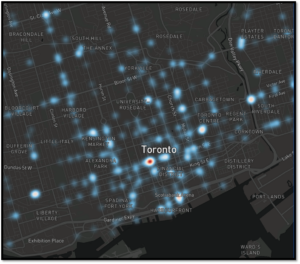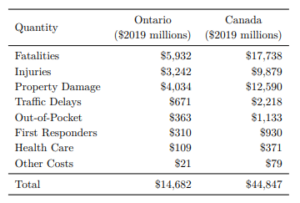Written by Sonam Sapra, Associate, and Jamie Davison, Student-At-Law
Introduction
This February has been the most dangerous month on Toronto streets for pedestrians and cyclists since 2020. Within the span of just one month, 12 collisions involving pedestrians and cyclists, resulting in four tragic fatalities, illustrated the urgent need for enhanced road safety measures. These alarming figures cast a shadow over the ambitious goals set forth by the Vision Zero initiative, launched in 2016, and Vision Zero 2.0, launched in 2019, to eradicate road fatalities. However, now eight years after the initial launch, a recent study conducted out of York University in January unveiled a sobering reality: between 2016 and 2021, a staggering 9,700 pedestrians sought emergency care due to injuries sustained on Toronto’s streets. These statistics underscore the persistent gap between aspiration and reality in achieving pedestrian safety. In this article we aim to explore the causes of pedestrian injuries, the impact that they have on our communities, and the current solutions in place and their limitations.
Exploring the Causes
There is a constellation of factors that contribute to pedestrian accidents. It is the sheer number of variables involved which makes the problem so complex and difficult to solve. The following are a select few of the contributing factors to pedestrian accidents:
- Distracted driving: whether you’re eating, drinking, or changing the song on your dashboard, if driving is not your main concern while behind the wheel, you are putting the safety of pedestrians in danger.
- Impaired or drowsy driving
- Inclement weather
- Left turning vehicles: a left-hand turn requires the driver to cross an incoming traffic lane which can lead drivers to focus on other incoming vehicles and neglect their responsibility to ensure that the pedestrian crosswalks are clear before beginning their turn.
- Aggressive driving and speeding
- Lack of pedestrian-friendly infrastructure, including:
– narrow sidewalks or a complete lack thereof;
– poor visibility areas where pedestrian crossings are less obvious to drivers;
– narrow roads that are too small for large vehicles such as SUVs and trucks.
Below is a just a snapshot of a hotspot map of pedestrian-involved collisions from 2007-2017 generated using Toronto Police data. Click here to navigate the interactive map.
There are endless variations of combinations of these factors that create the perfect recipe for a collision. However, all four fatalities that occurred in February of this year had something in common. While one might assume that the cause of Toronto pedestrian accidents must be busy city streets in the downtown core, all four fatalities occurred in the inner suburbs, where streets are wide, where traffic is fast, and where city hall has not spent nearly enough time or money on road safety.
Impact on Communities
Pedestrian accidents affect more than just those involved in the collision. There are societal and economic costs of pedestrian accidents. These include medical expenses, loss of productivity, and the emotional toll on family members.
In a study published in July 2023 by the Canadian Centre for Economic Analysis Toronto, titled: Social Cost of Collisions in Ontario and Canada: Technical Documentation, researchers broke down the cost of collisions in Ontario and Canada in 2019.
In the above chart, the researchers attempted to place a dollar amount on the consequences that occur as a result of a collision in Ontario and Canada. While these statistics do not explicitly discuss pedestrian collisions, we get an idea of the wide-ranging effects of a collision of any kind. For example: “health care” costs include the cost of hospitalization and emergency department visits, “first responder” costs include ambulance, police, fire, and tow truck costs, and “other costs” include the costs of the coroner, funerals, and court time.
Pedestrian collisions also disproportionately impact vulnerable populations including children, the elderly, and low-income communities. For example, Statistics Canada released this past October that the rate of pedestrian fatalities is highest among seniors aged 70 years and older. Statistics Canada suggests that “a higher fatality rate among seniors may be linked to a decline in muscle strength, balance, reaction time, vision, and hearing. These vulnerabilities make it more difficult to see oncoming traffic, get around on foot quickly, and judge distances correctly”. It is crucial here to note that these reasons place the onus on pedestrians to avoid being hit by cars as opposed to placing the onus on drivers to avoid hitting pedestrians – as is the requirement by law.
Current Solutions and Their Limitations
There are shortcomings in the existing initiatives and policies aimed at reducing pedestrian fatalities. The above-mentioned study from York University researchers compared data from multiple sources, including Toronto police, emergency room visits, and hospitalizations, revealing disparities in the numbers reported. While police data captured a portion of injuries, it represented only a fraction of emergency room visits and hospitalizations. The authors emphasize that relying solely on police data may not accurately capture the full extent of cyclist and pedestrian injuries in the city which has implications for both the health-care system and road safety planning, as city planners rely upon an inaccurate representation of the pedestrian collisions in Toronto.
Toronto City Councillor, Dianne Saxe told CBC news:
“Because the city has been on starvation budget for the last 13 years, we’ve allowed our infrastructure to fall apart around us — and even the current city budget still forecasts that the physical structure of our city is going to be increasingly falling apart year after year”. The failure to fund and maintain infrastructure increases “our long-term costs … and we adversely affect people’s lives, and all of these accidents are a real sign of that”.
While the budget allocated to the Vision Zero Road Safety Plan (RSP) has increased significantly, reaching $72.8 million in 2023, there are still challenges to overcome. Community groups and coalitions are forming to make streets safer by advocating for steps to be taken including reducing speed limits city-wide and reallocating road space to provide car-free spaces for transportation. These measures demonstrate a proactive approach to improving road safety but may face implementation challenges and resistance from stakeholders.
While efforts have been made to address pedestrian collisions in Toronto, there are notable limitations and challenges that must be addressed. Integrating data from multiple sources, increasing funding for road safety initiatives, and fostering community engagement are crucial steps towards achieving meaningful reductions in pedestrian injuries and fatalities.
Contact McLeish Orlando
If you or a loved one has been injured in a pedestrian accident, it is important to contact experienced legal counsel for advice. Here at McLeish Orlando, we have over 25 years of experience navigating pedestrian claims. Contact a personal injury lawyer at McLeish Orlando for a free consultation today.







